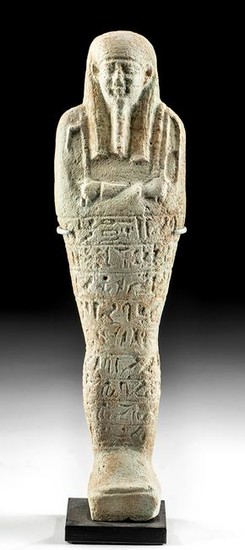Fine Egyptian Faience Ushabti w/ Inscription
Egypt, Late Dynastic Period, 26th to 31st Dynasty, ca. 664 to 332 BCE. A tall and handsome ushabti figure, mold-formed from faience and glazed with a lovely turquoise-hued glaze. The figure stands in mummiform in front of a dorsal pillar atop an integral rectangular plinth, holds a symbolic pick and hoe in arms crossed atop the chest, and has a petite seed bag behind the left shoulder. The peaceful countenance features almond-shaped eyes with elongated canthi, a triangular nose, full lips with indented corners, cupped ears, and a plaited false beard, all beneath a finely striated tripartite wig with slender lappets. Nine rows of inscribed hieroglyphic text wrap around the legs and lower body and, while untranslated, provide the name of the deceased as well as protective incantations from Chapter 6 of the Egyptian Book of the Dead (or "Book of Going Forth by Day"). Size: 1.9" W x 7.2" H (4.8 cm x 18.3 cm); 7.4" H (18.8 cm) on included custom stand.
Ushabti dolls are figures shaped like adult male or female mummies wearing traditional ancient Egyptian headdresses. The ancient Egyptians believed that after they died, their spirits would have to work in the "Field of Reeds" owned by the god of the underworld, Osiris. This meant doing agricultural labor - and it was required by all members of society, from workers to pharaohs. The wealthier nobility in Egyptian society were able to have shabtis made of faience; turquoise faience was meant to reflect the color of the river Nile both on earth and in the afterlife.
Provenance: private East Coast, USA collection; ex-Dr. Sid Port collection, California, USA, acquired in the 1980s
All items legal to buy/sell under U.S. Statute covering cultural patrimony Code 2600, CHAPTER 14, and are guaranteed to be as described or your money back.
A Certificate of Authenticity will accompany all winning bids.
We ship worldwide to most countries and handle all shipping in-house for your convenience.
#153159
Condition Report: Minor abrasions and pitting to legs, body, and head, with fading to original glaze pigmentation, light encrustations, and softening to some finer details, otherwise intact and excellent. Light earthen deposits throughout, and nice traces of original glaze pigment in scattered areas. Hieroglyphs are still mostly legible.
View it on
Sale price
Estimate
Time, Location
Auction House
Egypt, Late Dynastic Period, 26th to 31st Dynasty, ca. 664 to 332 BCE. A tall and handsome ushabti figure, mold-formed from faience and glazed with a lovely turquoise-hued glaze. The figure stands in mummiform in front of a dorsal pillar atop an integral rectangular plinth, holds a symbolic pick and hoe in arms crossed atop the chest, and has a petite seed bag behind the left shoulder. The peaceful countenance features almond-shaped eyes with elongated canthi, a triangular nose, full lips with indented corners, cupped ears, and a plaited false beard, all beneath a finely striated tripartite wig with slender lappets. Nine rows of inscribed hieroglyphic text wrap around the legs and lower body and, while untranslated, provide the name of the deceased as well as protective incantations from Chapter 6 of the Egyptian Book of the Dead (or "Book of Going Forth by Day"). Size: 1.9" W x 7.2" H (4.8 cm x 18.3 cm); 7.4" H (18.8 cm) on included custom stand.
Ushabti dolls are figures shaped like adult male or female mummies wearing traditional ancient Egyptian headdresses. The ancient Egyptians believed that after they died, their spirits would have to work in the "Field of Reeds" owned by the god of the underworld, Osiris. This meant doing agricultural labor - and it was required by all members of society, from workers to pharaohs. The wealthier nobility in Egyptian society were able to have shabtis made of faience; turquoise faience was meant to reflect the color of the river Nile both on earth and in the afterlife.
Provenance: private East Coast, USA collection; ex-Dr. Sid Port collection, California, USA, acquired in the 1980s
All items legal to buy/sell under U.S. Statute covering cultural patrimony Code 2600, CHAPTER 14, and are guaranteed to be as described or your money back.
A Certificate of Authenticity will accompany all winning bids.
We ship worldwide to most countries and handle all shipping in-house for your convenience.
#153159
Condition Report: Minor abrasions and pitting to legs, body, and head, with fading to original glaze pigmentation, light encrustations, and softening to some finer details, otherwise intact and excellent. Light earthen deposits throughout, and nice traces of original glaze pigment in scattered areas. Hieroglyphs are still mostly legible.




